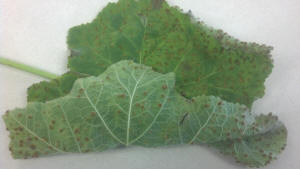|
 Hollyhock rust, fire
blight, reminders Hollyhock rust, fire
blight, reminders
By John
Fulton
 Send a link to a friend
Send a link to a friend
[June
20, 2013]
Hollyhocks are one of the
traditional, old-fashioned flowers often grown in our area. This
year, they are definitely interesting. Even before the flowers open.
Most area hollyhocks are infected with rust. Rust is usually a
spring and fall disease problem, when it occurs.
|
 Rust first shows up on the bottom of the lower leaves, and the
top side of the leaves develops some rather striking bright
yellow to orange spots. Rust can attack all plant parts,
including leaves, stems and leaf petioles. Rust first shows up on the bottom of the lower leaves, and the
top side of the leaves develops some rather striking bright
yellow to orange spots. Rust can attack all plant parts,
including leaves, stems and leaf petioles.The rust disease
spends the winter in old plant parts on the ground, so removal
of the plant material will help reduce infection possibilities.
Increasing air flow and reducing humidity will also help.
Control is best accomplished by removing infected leaves at the
first sign of the rust (on the bottom of the leaves). Chemical
control may be needed, and sprays containing sulfur are
effective. Also effective at preventing new leaves from being
infected are many of the protective fungicides.
Fire blight

Apple and pear trees continue to have their problems. There
is a large amount of tip dieback in some varieties, and this is
probably fire blight. Look for a shepherd's crook at the tip of
the affected areas as a clue it is fire blight. Fire blight is a
bacterial disease; therefore, there is little chance for you to
treat it.

[to top of second column]
|

The common treatment in commercial operations is streptomycin, but
it has to be applied before symptoms appear. If you are lucky, you
may be able to find these products in the better-stocked outlets. In
some years, Bordeaux mixture can also help prevent the disease --
and that means prevent and not cure. The disease is also hitting the
ornamental pears rather hard in some years.
Reminders
We are now in the middle of the correct planting time for the
warm-loving vegetables for our gardens. This would include lima
beans, cucumber, eggplant, melons, peppers, summer squash, winter
squash and pumpkins. Pumpkins for use as fall ornamentals should be
planted now for fall display. We're at the proper timing for fall
garden plantings for potatoes, kale and some others. Some of the
planting dates overlap this time of year. That basically means plant
it, but you can expect harvest to be closer to fall.
Keep pruning flowering shrubs after they complete bloom. That
will allow for more flower buds for next year. Also, start pruning
evergreens at this time.
[By
JOHN FULTON,
University of Illinois Extension] |